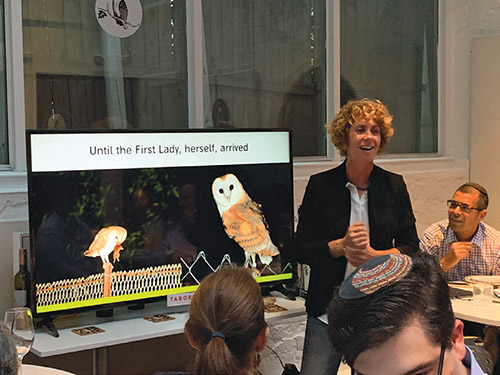






Michal Akerman, an agronomist and the viticulturist from Israel’s Tabor Winery, visited the U.S. this week, speaking to groups about the winery’s latest bottles and its brand-new labeling, which features a beautiful rendering of a barn owl. The barn owl, the likeness of which is based on a real owl that currently nests in a Tabor vineyard, represents a change in the company’s agricultural practices and its recent certification from the Society for the Preservation of Nature. That process has involved using natural fertilizers and introducing native plants back to the vineyards, and welcoming back insects and wildlife like jackals, wolves, wild boars, storks, lizards and chameleons. Tabor is both the first and currently the only winery in Israel to have this ecological certification.
I had the opportunity to meet and hear Akerman speak at the upscale restaurant Noi Due Carne in Manhattan, where she presented wines at a pairing dinner sponsored by Royal Wine, Tabor’s distributor. While the wines were the true star of the evening, the unique approach that Akerman described was equally fascinating; her regard for improving the wildlife within the vineyards was coupled with an eye toward the ever-increasing quality of the vineyard’s grapes, which, she explained, accounts for 90 percent of good wine. Better biodiversity, she reasoned, between plants and animals in vineyards creates a more stable ecosystem that can protect against disease and outbreaks, both among plants and animals, while at the same time increasing the quality of the grapes.
Tabor, a four-family winery launched in 1999 but originally established for viticulture in 1901 by the Rothschild family, had its majority shares bought in 2005 by Coca-Cola Israel. It is still run by the families and the same team. Tabor now has multiple vineyards around Israel’s five wine-growing regions, from the north in the Galil near Mount Tabor to the southern end of Israel in the Negev. The vast disparity between soil, topography, altitude and climate has given Akerman and her colleagues an interesting challenge in terms of “what grows best in which climate.” Winemaker Arieh Nesher, who has been with Tabor since its inception and has been making wine for over 40 harvests (making him the most senior winemaker in Israel), works with Akerman. Or Nidbach, a UC Davis-trained winemaker, rounds out their team. Their work in agronomy and viticulture has been written up in various academic journals and they have become known outside Israel as subject-matter experts.
Akerman also shared her interest in bringing varietals to Israel from other countries and making excellent wines from them, giving unique opportunities to the kosher wine drinker. Tabor introduced roussanne as a varietal at Tabor in 2012. Another such example was the tannat grape, which is native to Uruguay, and Tabor Winery’s 2014 Single Vineyard Tannat was served at the dinner. Of all the wines served, this was my favorite. It was an exciting wine with the warmth typical of merlot or marselan, but with very subtle aromas of dark berries on the nose, and green tea closer to the finish. That wine was served sandwiched between the Tabor Adama Shiraz 2014, one of Tabor’s flagship standard excellent wines (served alongside a lamb kufta with a white bean puree, pictured below), and the Tabor Malkiya Cabernet Sauvignon 2014. The Malkiya was a particularly fascinating wine to taste, and it was truly one of the best and most unique and aromatic cabernets I have had. Akerman explained that Malkiya Mountain in northern Israel has a very exceptional rock-plated topography that is very hard to irrigate, making anything difficult to grow. But, Akerman reminded, “as a rule, cabernet grows best in stressed conditions.” Intense additional irrigation and other changes in the vineyard has made this wine both unique and award-winning. It consistently scores highly in competition, consistently scoring above 90 points in worldwide publications.
Speaking of scoring, it’s good to know that Wine Spectator has three times selected a Tabor wine for its top 250 list, and this, showcased at its prestigious annual Wine Spectator grand tasting, literally “put Israel on the map” of great wines of the world.
Also served at the dinner and certainly worthy of an endnote mention was the truly lovely Tabor Adama Sauvignon Blanc 2018, which I wrote about in my most recent Shavuot white wines article in May. This New Zealand-style almost-translucent wine continues to be a delightfully crisp and fun white, ideal to cut through this summer’s humidity. The nose is full of tropical fruit and citrus and finishes with more subtle notes of grapefruit and stone fruit or melon.
By Elizabeth Kratz
�










